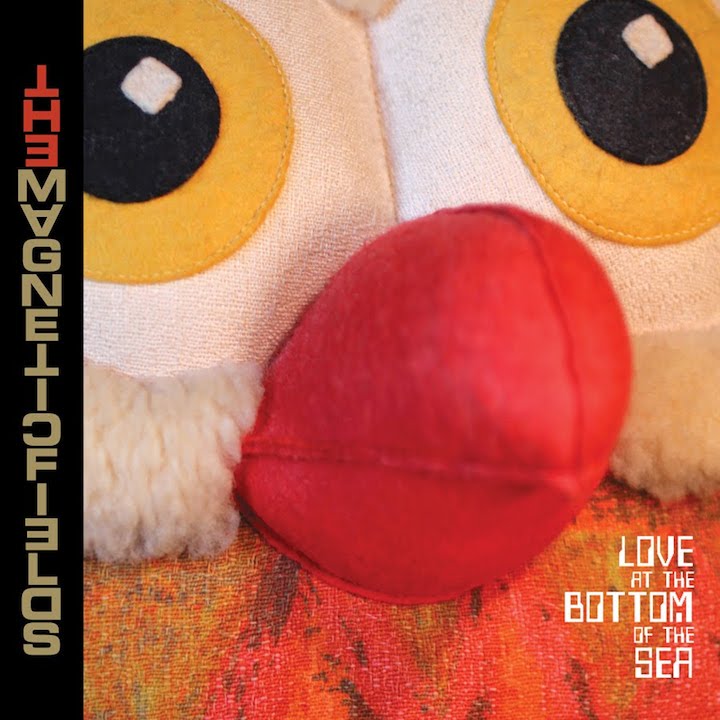
The Magnetic Fields’ Love at the Bottom of the Sea
Stephin Merritt, the musical arch-contrarian behind American pop fabulists The Magnetic Fields, knows a thing or two about artifice. More specifically he understands that, at its most fundamental level, all music is artifice—what separates music (even musique concrète, music created from recordings of natural noise) from mere noise is the fact that it has been manipulated to some extent by human beings. Despite this, Western culture in general continues to discuss music as though some forms of it are more ‘real’ than others. By consensus, we proclaim that a man with dreadlocks strumming a guitar is more ‘real’ than a woman in lycra singing along to a backing track. Often what counts as ‘real’ or ‘authentic’ intersects with race, gender and sexuality in depressingly predictable ways: punk and rock, largely the domain of straight white guys, are ‘real’ in a way that disco (too gay), pop (too girly), and rap (too black) could never be.
Merritt’s works aim to escape this false dichotomy through hyperbolic performances of artifice. He is rigorously committed to music that sounds almost entirely ‘inauthentic’, and pursues this goal through a variety of means—cheap-sounding Casiotone synthesis (most predominant in early Magnetic Fields albums), stiffly formal arrangements (Realism), melodies drowned out in washes of guitar feedback (Distortion). It’s therefore no accident that he’s drawn to making concept albums—since, if all music is artifice, aren’t all albums concept albums, differentiated only how explicitly their creators recognise and cleave to said concept?
Of course, this musical project has personal and political resonances. Given that Merritt is both openly gay and from a country where homosexuality and other forms of queer desire are routinely demonised as ‘unnatural’, his infatuation with artifice can be read as a strident defence of cosmopolitan liberal gayness. It should come as no surprise that Merritt’s lyrics are often either explicitly about gay experience or are particularly slippery in their use of pronouns. (‘Reno, Dakota’ from 69 Love Songs perfectly demonstrates this. Vocalist Shirley Simms implores her lover, gender unspecified: “Have I annoyed you or is there a boy who—? / Well, he’s just a whore / I’ve had him before.”) The political import reveals the personal import: Merritt’s great theme is love—gay, straight or in-between—and he explores this supposedly most natural phenomenon through his rigorously formal music. That might seem like a contradiction, but part of what makes Merritt’s music so interesting is that he fully understands the power of cliché—and even out-and-out corniness—to move the listener.
The threads of Merritt’s musical project have never been more tightly integrated than on The Magnetic Fields’ tenth and latest album, Love at the Bottom of the Sea. This is despite the fact that it doesn’t have much of a driving concept—like 69 Love Songs, it’s about love, but unlike that album, there’s no joke implicit in the title. It eschews the ‘no-synthesiser’ rule that Merritt imposed upon his band for their past three albums. The only limitation imposed here is on the length of the songs (all of which fall somewhere between two to three minutes), but even that seems more to reflect Merritt’s own stated belief that longer songs are boring rather than functioning as the kind of restriction that enables creativity. This leaves Love at the Bottom of the Sea free to be a pure expression of Merritt’s musical raison d’être, which is the source of both the album’s strengths and weaknesses.
Fortunately, there are more strengths than weaknesses. Opening track ‘Your Girlfriend’s Face’ is a delight of sharp songwriting—a hook-laden melody for both the chorus and verses, with Shirley Simms delivering an appropriately vitriolic performance as a jilted lover. That track is followed by album highlight ‘Andrew in Drag’, in which a young heterosexual man (voiced by Merritt’s rich baritone) finds himself ruined for all other women after seeing his friend Andrew in drag. A good deal of the pleasure of this song is hearing how effortlessly Merritt deploys simple rhyme schemes that would sound heavy-handed in other artists’ repertoires—every line in the song ends with a word that rhymes with ‘drag’. (“The moment he walked on that stage, my tail began to wag / Wag like a little wiener dog for Andrew in drag.”)
The corollary to all of this artifice is that the album can sometimes feel either predictable or strained: for example, the gags of ‘The Horrible Party’ can be seen coming in advance (“People are shedding their inhibitions and their clothes / … Everyone seems to be stuffing something up his nose”). Merritt’s insistence on artifice and cliché is also guaranteed to create at least one song per album that will rub any given individual listener the wrong way for entirely idiosyncratic reasons—perhaps for the forced feeling of the rhyming lyrics, the anodyne cheeriness of the melody or the astroturf-like timbre of the synthesiser patches.
If annoyance is the risk that Merritt’s musical project runs, then it’s one he seems more than willing to take—and perhaps one that we, as listeners, should also take. Love at the Bottom of the Sea is a neon-coloured, artificial-cherry-flavoured, plastic stinkbomb lobbed into 2012’s music culture. The way it uses cheesy melody, simple rhyme schemes and plasticky synthesisers to express deep human emotion sounds like an essential message at a time when Lana Del Rey’s ‘authenticity’ or lack thereof can fuel an entire blog ecosystem. Postmodern theory may be deeply uncool at the moment, but it’s refreshing to hear an album that’s as committed to exposing the depth in superficiality, and the superficiality in depth as Love at the Bottom of the Sea.
